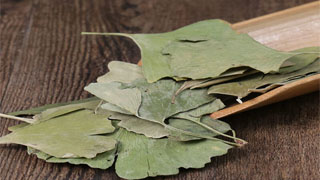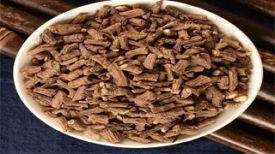
1. Alias
Duck feet, white fruit leaves, and white sun leaves.
2. Plant morphology
Tall deciduous trees, reaching up to 30-40 meters in height. The trunk is upright, the bark is light gray, yellow brown when old, and longitudinally cracked. Branches are divided into long and short branches. Leaves cluster on short branches or spiral scattered on long branches; The leaf blade is fan-shaped, with a shallow wavy upper edge, sometimes with a shallow or deep central fissure, and forked branching veins; The petiole is long. The flowers are solitary and heterozygous, rare and common, and the bulbous flowers grow in the axils of short branches or bracts, blooming simultaneously with the leaves; The male bulbous flower is in the shape of a flexible inflorescence; The female bulbous flower has a long stem with two forked ends. The forked end bears a bead seat, and each bead seat bears an ovule, with only one developing. The seeds are drupe shaped, elliptical to nearly spherical in shape, with fleshy outer seed coat and white powder. When ripe, they are orange yellow in color, while the inner seed coat is bony and white. The flowering period is in May and the fruiting period is in October.
3. Origin distribution
Cultivated throughout the country. Distributed in Guangxi, Sichuan, Henan, Shandong, Hubei, Liaoning and other places.
4. Harvesting and processing
Harvest leaves from June to September, remove impurities, and dry them in a timely manner.
5. Characteristics of medicinal herbs
Yellow green, smooth and hairless, often broken or folded. The complete leaves are fan-shaped, with shallow or deep fissures and bifurcating veins. The petiole is thin, lightweight, easy to tear, with a fragrant aroma and a slightly astringent taste.
6. Sexual Taste Returning to the Classics
Flat in nature, sweet, bitter, and astringent in taste. Returning to the Heart Meridian and Lung Meridian.
7. Effect and Function
Consolidate the lungs, relieve asthma, promote blood circulation and remove blood stasis, and relieve pain. Belonging to the subcategory of astringent drugs, it is a lung astringent intestinal medicine.
8. Clinical application
Take 9-12 grams and decoct; Or use extracts as tablets; Or into pills or powder. External use: appropriate amount, tamped or applied; Or boil and wash with water. Used to treat lung deficiency cough and asthma, coronary heart disease, angina pectoris, hyperlipidemia, etc.
9. Pharmacological research
Can improve cerebral circulation and have a protective effect on brain cells and blood-brain barrier; It can improve learning and memory, protect nerves, reduce hearing nerve damage, and significantly improve aging, dementia, and brain dysfunction; For the cardiovascular system, it can reduce myocardial oxygen consumption, protect ischemic myocardium, reduce the occurrence of arrhythmia, dilate blood vessels, and inhibit angiotensin-converting enzyme (ACE); Eliminate free radicals and resist lipid peroxidation; Antiplatelet activating factor, inhibits platelets; Has the effect of enhancing biofilm stability. It has a direct relaxing effect on tracheal smooth muscle and a spasmolytic effect on gastrointestinal smooth muscle; Has a lipid-lowering effect; Has antimicrobial properties; Can increase the secretion of sebaceous glands, making dry or aging skin more rosy in color. Through experiments, it has a vasodilatory effect on arterial blood vessels and can counteract the vasoconstriction caused by adrenaline. In addition, it has a cholesterol lowering effect.
10. Chemical composition
Containing isorhamnetin, kaempferol, quercetin, rutin, quercitrin, flavonoids from white fruit, paeoniflorin A, and β - paeoniflorin C (Ginkgolides A GinkgolidesB、Ginkgolides C)、 Tea essence, etc. In addition, it contains ingredients such as isoquercetin, diopside, bayberry bark extract, syringin-3-glucoside, 6-hydroxycanine uric acid, trans linalool oxide, white fruit acid, white fruit phenol, and white fruit alcohol.
11. Usage taboos
Do not use if there is a real evil.
12. Compatibility prescription
① Treatment of high serum cholesterol: Ginkgo biloba leaves extract the main component flavonoids and make sugar coated tablets, each containing 1.14 milligrams of flavonoids, 4 tablets per time, 3 times a day. (National Compilation of Chinese Herbal Medicines)
② Treatment of diarrhea: Ginkgo biloba leaves as the powder, mixed with flour to make a cake, simmered and cooked. (Essentials of Pinhui)
③ Treatment of pediatric enteritis: Boil 3-9g of Ginkgo biloba leaves in water and scrub the soles, palms, and openings (around the Juque acupoint) of the child's feet. In severe cases, wipe the top of the hair twice a day. (National Compilation of Chinese Herbal Medicines)
④ Treating freckles: Ginkgo biloba leaves, mashed and applied, very wonderful. (Diannan Materia Medica)
⑤ Treating onychomycosis: Boil ginkgo leaves and wash with water. (Southern Medicine, Chinese Herbal Medicine)
⑥ Treatment for corns: 10 fresh ginkgo leaves, mashed, wrapped and applied to the affected area. After 2 days, the leaves turn white and rot. Use a small knife to remove the hard pieces. (Southern Medicine, Chinese Herbal Medicine)
⑦ Treating lacquer sores, swelling, and itching: Boil and wash Ginkgo biloba leaves and honeysuckle vine with water, or boil and wash Ginkgo biloba leaves alone. (Southern Medicine, Chinese Herbal Medicine)
⊙ The content of the article is for clinical reference only. Non TCM professionals are not allowed to test drugs.


